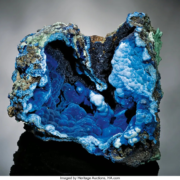Azurite: Properties, Uses and Virtues
Azurite is an intense blue copper mineral, often mixed with malachite as azurmalachite, formed in the oxidation zones of copper deposits. Used since ancient times, notably by the Egyptians and in the Middle Ages as a pigment for religious art, its powder is toxic. Renowned for stimulating spiritual awareness and mental clarity, Azurite is mined mainly in France, the United States, Mexico, Namibia and Russia. With a hardness of 3.5 to 4 on the Mohs scale, it is fragile and requires delicate care. Although rarely processed, it can be mixed with malachite and plastic to form reconstituted azurmalachite.

Azurite: Table of contents
- The Short Version For Busy People
- Azurite Geological Formation
- Rough Azurite – Raw Beauty Revealed
- Sources – The Worldwide Scope of Azurite
- Historical Significance of Azurite – Through the Ages
- Metaphysical Properties of Azurite – Illuminating energies
- Azurite Varieties
- Azurite Colors
- Durability and Wearability of Azurite
- Azurite Enhancements – Preserving Natural Beauty
- Synthetic Azurite – Nature in the Laboratory
- Imitations of Azurite – Discerning the Authentic
- Azurite Care – Preserving natural beauty
- Sources
Azurite Geological Formation
Azurite is a copper mineral that forms in the oxidation zones of copper deposits. This geological process generally occurs in arid environments where carbonate rocks and copper-rich solutions interact, leading to the precipitation of Azurite. Azurite formation involves chemical transformations and interactions between water, carbon dioxide and copper-rich minerals, creating its characteristic blue hues.
Rough Azurite – Raw Beauty Revealed
Uncut Azurite displays unique crystal formations and fascinating natural patterns. Azurite crystals are rare and show distinct prisms. It can also be found in stalagmites or in massive form. In this case, it is very often mixed with malachite and is sometimes called “azurmalachite”.
Azurite has a strong tendency to transform into malachite over time!
Sources – The Worldwide Scope of Azurite
Azurite is mined in various parts of the world, each deposit offering specimens with unique nuances and characteristics. Major Azurite producers include France, the United States (notably Arizona), Mexico, Namibia and Russia.
Historical Significance of Azurite – Through the Ages
Azurite, with its deep blue hues, has captivated civilizations throughout history, mainly used as pigment and ornament. Since ancient times, it has been ground into a fine powder to create an intense blue pigment, used in art and decoration.
Ancient Egypt: The Egyptians used Azurite not only for its ornamental properties, but also as a pigment for their wall paintings and funerary objects. This stone was associated with the goddess Hathor, symbol of beauty and love. However, it’s important to note that Azurite powder is toxic, and careful handling was necessary.
Middle Ages: In the Middle Ages, Azurite continued to be used as a pigment, particularly prized for its vibrant blue hue. It adorned illuminated manuscripts and religious paintings alongside Lapis lazuli. The image of the Virgin Mary and the Infant Jesus was often depicted with robes painted Azurite blue, symbolizing purity and holiness. The use of this precious pigment enhanced the sacredness and importance of religious works of art.Azurite and Malachite in pigment – Photo© by Lauréline Colliard, galerie de minéralogie du jardin des plantes
On the example of this medieval manuscript the blues are usually in Lapis Lazuli, but I found the site absolutely wonderful because you can read the whole manuscript and the quality and colors are superb, so I’m sharing it (linked above).
Metaphysical Properties of Azurite – Illuminating energies
Azurite is renowned for its metaphysical properties that stimulate spiritual awareness and mental clarity. It is believed to promote intuition, enhance meditation and aid communication with the spiritual realms. As a stone of transformation, Azurite encourages personal evolution and self-realization.
Azurite Varieties
Azurite has no distinct gemological variety.
Azurite Colors
Azurite displays rich shades of blue, from light blue to deep, almost black blue. This range of colors results from the different concentrations of copper in the stone. The most prized specimens feature an intense, uniform blue hue, often compared to ultramarine, making it a sought-after gem for jewelry and decorative objects.
Durability and Wearability of Azurite
Azurite has a hardness of 3.5 to 4 on the Mohs scale, making it relatively soft and very brittle. This low hardness requires special care to avoid scratches and damage. It is very rarely cut and worn as jewelry, as enthusiasts prefer to collect it in its natural state.
Azurite Enhancements – Preserving Natural Beauty
Azurite is rarely treated. Natural azurmalachite can be oiled or impregnated.
Synthetic Azurite – Nature in the Laboratory
Synthetic Azurite exists for research purposes, but is not widely available on the gem and jewelry market due to its fragility, production costs and lack of public appeal.
Imitations of Azurite – Discerning the Authentic
Azurite can be imitated or misrepresented on the market. Buyers should be wary of materials such as sodalite, lapis, tinted stones or glass replicas, which are often sold as genuine Azurites.
Reconstituted Azurmalachite is also available.
Azurite Care – Preserving natural beauty
To preserve the beauty of Azurite, it is crucial to handle it with care. Avoid exposure to chemicals, shocks and extreme temperatures. Clean gently with warm soapy water and a soft brush. Keep Azurite away from harder materials to avoid scratches and abrasions.



Leave a Reply
Want to join the discussion?Feel free to contribute!